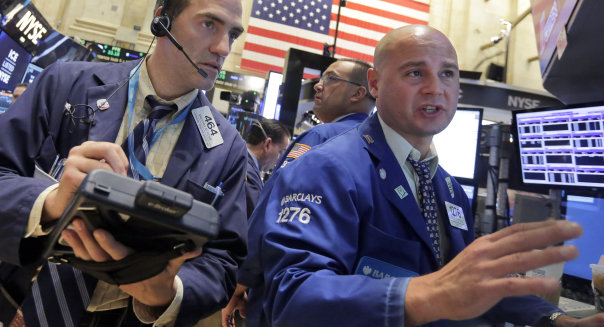
NEW YORK — Wall Street stocks closed lower Friday in heavy trading as the Federal Reserve’s decision to keep interest rates near zero fueled concerns about the potential impact of continuing weak global growth on U.S. corporate earnings.
Apart from the state of the world economy, the Fed cited financial market volatility and sluggish inflation at home in its decision Thursday, while leaving the door open for a modest policy tightening later this year.
Friday’s volatility was also likely exacerbated by so-called “quadruple-witching,” when options on stocks and indexes, and futures on indexes and single-stocks all expire, prompting investors to buy or sell shares to cover expiring contracts.
The three major stock indexes each fell more than 1 percent, with all 30 Dow components in the red.
“People are taking this to be another data point of a potentially deflationary environment. Deflation is bad for corporate profits and that leads to lower share prices,” said Stephen Massocca, Chief Investment Officer at Wedbush Equity Management in San Francisco.
The Fed’s decision suggested a global economic environment that is unlikely to foster the kind of earnings growth needed to support stocks at their current, above-average valuations.
Despite recent declines, the benchmark S&P 500 is still trading around 15.6 times forward 12 month earnings, above the 10-year median of 14.7 times, according to Thomson Reuters StarMine data.
“What they introduced [Thursday] was that they’re worried about the effects on U.S. growth based on foreign economies,” said Scott Colyer, chief executive officer of Advisors Asset Management in Monument, Colorado.
More than 10.9 billion shares changed hands on U.S. exchanges, compared with 8.1 billion average for the previous 20 sessions, according to Thomson Reuters (TRI) data.
It was the most active trading day since Aug. 24 when 14.2 billion shares changed hands as markets sold off on concerns about China’s economic growth.
The Dow Jones industrial average (^DJI) closed down 289.95 points, or 1.7 percent, to 16,384.79, the Standard & Poor’s 500 index (^GSPC) lost 32.12 points, or 1.6 percent, to 1,958.08 and the Nasdaq composite (^IXIC) dropped 66.72 points, or 1.4 percent, to 4,827.23.
Oil Price Slide
All 10 major S&P sectors ended lower, with the energy index’s 2.6 percent fall leading the decline on falling oil prices. Industrials and materials also dropped more than 2 percent. Financials fell 1.9 percent as banks would have benefited from an interest rate increase.
For the week, the Dow shed 0.3 percent, the S&P fell 0.1 percent and the Nasdaq rose 0.1 percent.
Investors are now focusing on the next Fed meeting on Oct. 27-28, though a growing number of economists, including those at Morgan Stanley and Barclays, now wonder whether the Fed will raise rates at all this year.
The CBOE volatility index, known as the “fear gauge,” jumped 5.4 percent to 22.28, above its long-term average of 20.
NYSE declining issues outnumbered advancers 2,139 to 929, for a 2.30-to-1 ratio; on the Nasdaq, 1,856 issues fell and 1,026 advanced, for a 1.81-to-1 ratio. The S&P 500 posted 4 new 52-week highs and 18 lows; the Nasdaq recorded 51 new highs and 65 lows.
-.
What to watch Monday:
The National Association of Realtors releases existing home sales for August at 10 a.m.
Earnings Season
These selected companies are scheduled to release quarterly financial results:
Lennar (LEN)
Red Hat (RHT)
•Wall Street Rallies on Fed Rate Hike
•Fed Raises Interest Rates, Cites Ongoing US Economic Recovery
•US Aerospace Sector Poised for 2015 Record Trade Surplus: Group


Leave a Reply